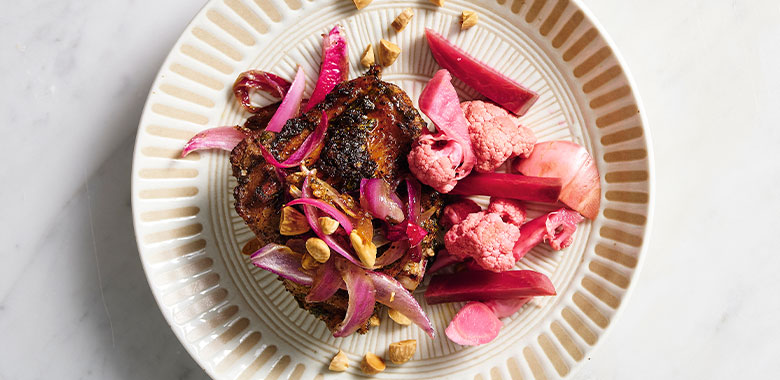
Food
Seasonal Pickles
With autumn underway, it’s perfectly fine to find yourself in a bit of a pickle... especially when the results are this mouth-watering.
Day for night, sunshine for shadow, summer for winter; there is such joy in the contrasts of nature. When I find myself impatient for the shift, I revel in the wonderful smugness of finding a little sunshine tucked away in my cupboard. On the sweeter end of the spectrum, a jar of strawberry or peach jam is a winter morning favourite, but if I’m chasing savoury, it’s the pickle jars that sate my impatience.
A process dating back thousands of years, pickling is a way of preserving produce to extend its shelf life, pausing your vegetables at their seasonal best, often when a little glut means the prices are at their best too. For all that joy, it is possible the true wonder of this process is not in the taste of a season gone by, but the way it can change those flavours, unlocking delicious umami within, while also making them easier to digest. A culinary and scientific wonder!
What are the health benefits of pickling?
In order to talk pickling, we need to start with an understanding of the world of fermentation. This is the process responsible for beer, wine, bread, cheese, yoghurt, vinegar, chocolate, soy sauce, miso, and kimchi, to name just a handful. When we ferment something we set to work a bevy of bacteria and micro-organisms which, given the right conditions, will begin beavering away to help make them more digestible.
Most raw produce will bring their own micro-organisms to the party on their skins or surfaces, simply requiring our help to provide them with the right environment to kick things off: that is often anerobic (without oxygen) and salty (to help keep other nasties at bay); after that, it’s really just a question of time. The micro-organisms – specifically bacteria, yeasts and mould – break down more complicated foodstuffs rendering them more easily digestible, nutritious and delicious: as grapes make their way from wine to vinegar; as soy beans change into soy sauce, tempeh or miso; or anchovies that can be found in an ancient garum or a more modern Worcestershire.
Interest in these processes and their resulting recipes has been piqued over the past decade or so as we have begun to have a better understanding of the importance of our gut health, and thus the pre- and probiotics that help to nurture a healthy microbiome. Isn’t it wonderful when deliciousness is what the doctor orders?
And so to my mid-winter savoury saviour – pickles. An etymological pickle in itself, this somewhat generic term can refer to lively fermented foods, or those simply preserved in vinegar which, perhaps confusingly, is a ferment itself!
Due to their important role as preserver, especially before refrigeration, pickles and ferments can be found in almost all cultures and cuisines around the world: Korean kimchi, German sauerkraut, the lime pickles of India, and the olives of the Mediterranean; the ubiquitous pickled ginger in Japan or their preserves, delightfully referred to as konomono or “fragrant things”. What wonders!
In my house, it’s the joy of a jar of cornichons in the fridge (and an excuse to own a pair of those wonderful little cornichon tongs for fishing them out of giant glass jars in France); fat jars of vibrant preserved lemons on my shelves; the crunch of a light pickle of radishes, daikon, ginger or cabbage with simple bowl of rice; or the soothing transformation of a very quick shallow-pickled eschalot in with my favourite salad dressing. A little sunshine, waiting for me when I need it most.
What is the best way to select produce for pickling?
Late summer represents a good time for pickling, as there is a wonderful bounty of fruit and vegetables that are stocked with sunshine for the coming winter. You’re going to need living fruit for this – think organic – and don’t wash them too thoroughly. On the store-bought front, there is absolutely nothing wrong with a vinegar pickle – in fact, the opposite – however the distinction is important for those seeking fermented goods to provide good sustenance for their gut.
What is the best way to store pickled food?
The very reason vinegar is used to hold vegetables is due to its ability to preserve, by killing off any potentially dangerous bacteria (often taking the good ones along with them). If you are looking for a ferment, you will most likely need to make your own (see Lyndey’s sauerkraut recipe), or seek out live ferments in a good health food store (as opposed to most commercial pickles, which in a general sense is all that you will find in a supermarket).